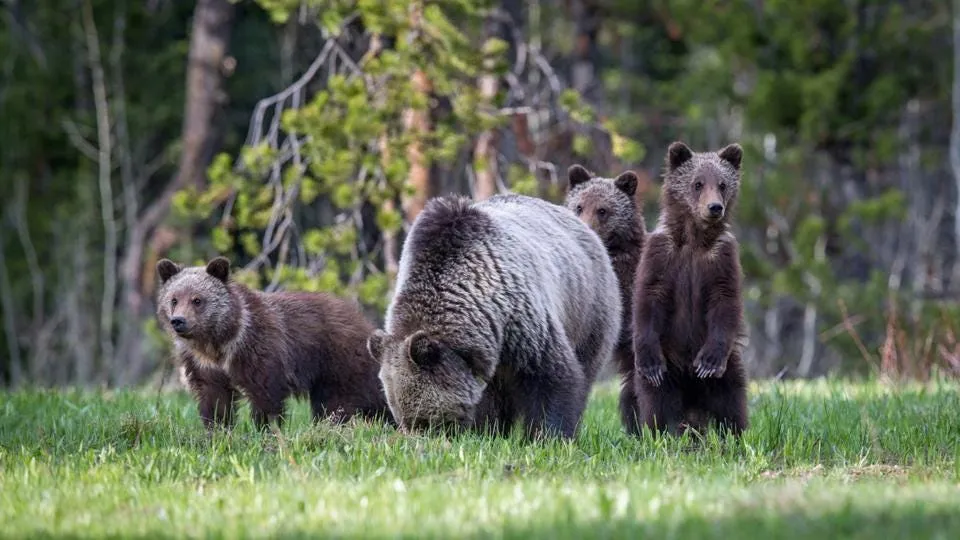Montana, with its pristine beauty of rolling mountains and vast prairies, has long been known as one of the states with the largest gray wolf populations in the United States. More than just a symbol of wild nature, wolves play a crucial role in maintaining ecological balance. If you are a nature lover and wish to witness the majestic beauty of these animals in their natural habitat, Montana is the ideal destination. This article from “Du lịch khắp thế gian” (Travel the World) will provide a guide to visiting wolf sanctuaries in Montana, helping you have a memorable and meaningful exploration.
Montana is not only famous for the magnificent Glacier National Park or charming mountain towns, but also as a habitat for rare gray wolves. Visiting wolf sanctuaries here is not just an opportunity to admire their beauty but also a chance to learn about their history, behavior, and conservation efforts for this special animal. From the world-renowned Yellowstone National Park to lesser-known wilderness areas, Montana offers diverse options for those wanting to explore the world of wolves. Join “Du lịch khắp thế gian” to discover fascinating destinations and equip yourself with the necessary knowledge for a fulfilling trip.
Discovering Montana’s Gray Wolf World: Yellowstone & Beyond
Yellowstone National Park, although mostly located in Wyoming, has its North Entrance opening into Montana, making it an ideal starting point for a wolf sanctuary tour. Yellowstone is globally renowned for its diverse ecosystem, magnificent geysers, and especially its abundant wildlife, including gray wolves.

Historically, gray wolves faced extinction in Yellowstone and many other areas in the United States due to hunting and habitat destruction. However, thanks to persistent conservation efforts since the 1990s, the gray wolf population in Yellowstone has recovered strongly. Today, the northern part of the national park, especially the Lamar Valley, is known as the “Serengeti of North America” and is one of the best places in the world to observe gray wolves in their natural environment.
For effective wolf sanctuary visits in Yellowstone, you can choose various approaches. Hiking is a great way to immerse yourself in nature and increase your chances of encountering wolves or their tracks. However, to ensure safety and optimize your experience, you should join guided tours led by experienced local guides. They are not only knowledgeable about wolf behavior but also know the areas with high observation potential, while also equipping you with essential knowledge about wildlife conservation.
Beyond Yellowstone, Montana also boasts many other wilderness areas that are ideal habitats for wolves. Flathead National Forest, located in Northwest Montana, adjacent to Glacier National Park, is also an attractive destination for those wanting to visit wolf sanctuaries. This area features diverse terrain from high mountains to dense forests, creating a rich habitat for many animal species, including gray wolves. Similarly, Lolo National Forest and Bitterroot National Forest in Western Montana are also worthy considerations.
The Miraculous Recovery of Gray Wolves in Yellowstone
The story of gray wolf recovery in Yellowstone is a prime example of successful conservation efforts worldwide. In the late 19th and early 20th centuries, the U.S. government’s predator control policies pushed gray wolves to the brink of extinction in Yellowstone. From 1914 to 1926, at least 136 wolves were killed in the national park. By the 1940s, there was almost no information about any wolf packs existing in Yellowstone.

However, awareness of the crucial role of wolves in the ecosystem gradually changed. By the mid-1990s, the U.S. National Park Service initiated a gray wolf reintroduction program into Yellowstone. From 1995 to 1997, 41 wild gray wolves from Canada and Western Montana were released into the national park. This program faced much controversy, especially from the livestock farming community, but the results achieved were incredibly impressive.
After more than 25 years, the gray wolf population in Yellowstone has grown strongly, not only in number but also in distribution range. Research shows that the return of wolves has had positive impacts on the Yellowstone ecosystem, including the recovery of riparian vegetation, an increase in beaver populations, and the rebalancing of populations of large herbivores like elk. This story is not only a beacon of hope for wolf conservation but also a valuable lesson about the importance of maintaining biodiversity and ecosystem balance.
“Day with the Wolves” Experience: Unique Tour in Yellowstone
To meet the increasing demand for wolf sanctuary tours, many travel companies have developed specialized tours, offering more unique and in-depth experiences for visitors. A prime example is the “Day with the Wolves” tour organized by Four Seasons Resort and Residences Jackson Hole in collaboration with Jackson Hole Wildlife Safaris and Yellowstone Safari Company.
This tour offers a luxurious and exclusive experience, starting with a private flight from Jackson Hole, Wyoming to the northern edge of the Yellowstone ecosystem in Livingston, Montana. Guests will be accompanied by a veteran naturalist who will share in-depth knowledge about the history, behavior, and habits of gray wolves. Then, the group will travel into Yellowstone National Park to observe wolves in their natural habitat using specialized wildlife viewing vehicles.
The highlight of the “Day with the Wolves” tour is not only its luxury and comfort but also its focus on education and conservation. Visitors not only have the opportunity to admire the beauty of wolves but also learn about the challenges they face and the conservation efforts being implemented. A portion of the profits from each trip will be donated to the Yellowstone Wolf Project and the Environmental Defense Fund, contributing to wolf research and management in Yellowstone.

Although the “Day with the Wolves” tour is aimed at the high-end tourist segment, it is a testament to how tourism can play a positive role in wildlife conservation. By creating meaningful and responsible travel experiences, we can raise public awareness about the importance of protecting rare animal species and their habitats.
Useful Tips for Your Montana Wolf Sanctuary Visit
To ensure your Montana wolf sanctuary tour is smooth and successful, “Du lịch khắp thế gian” shares some useful tips:
- Best Time to Visit: The ideal time to observe wolves in Montana is during winter and early spring (December to March). At this time, the white snow cover makes it easier to spot wolf tracks, and it is also their breeding season, increasing the chance of seeing entire packs.
- Essential Gear:
- High-quality Binoculars: These are indispensable for observing wolves from a distance without disturbing them.
- Camera with Telephoto Lens: If you want to capture memorable moments, a good camera with a telephoto lens will be very useful.
- Warm Clothing: The weather in Montana in winter is very cold, so prepare warm clothes, hats, gloves, and scarves.
- Hiking Boots: If you plan to hike, choose comfortable and grippy boots.
- Choose Reputable Tour Operators: If you have no experience visiting wolf sanctuaries or want to optimize your chances of observation, choose professional tour operators. Research the experience and reputation of the travel company, and consider reviews from previous customers.
- Maintain a Safe Distance: Always keep a safe distance from wolves and other wildlife. Do not feed them or attempt to approach too closely.
- Follow Instructions: If you join a guided tour, follow their instructions to ensure your safety and protect wildlife.
- Learn About Conservation: Take time to learn about wolf conservation efforts and how you can contribute to this work. Responsible tourism is a great way to support wildlife conservation and their habitats.

Visiting wolf sanctuaries in Montana is not just a trip but also a journey to explore wild nature and learn about ecological balance. Hopefully, with these detailed guides from “Du lịch khắp thế gian,” you will have a memorable and meaningful trip, contributing to the conservation of rare gray wolves and the pristine beauty of Montana.
Conclusion
Montana, with its vast nature reserves and healthy gray wolf populations, is an ideal destination for those passionate about exploring the wildlife world. The guide to visiting wolf sanctuaries in Montana from “Du lịch khắp thế gian” has provided you with the necessary information to plan a memorable trip. From choosing the right location and time, preparing adequately, to joining professional tours, each step of preparation contributes to creating a complete and meaningful experience.
More importantly, visiting wolf sanctuaries is not only an opportunity to admire the beauty of these animals but also a chance to raise awareness about the importance of nature conservation. Witnessing the miraculous recovery of gray wolves in Yellowstone is a great inspiration, showing that with the right efforts, we can successfully protect rare animal species and maintain ecological balance for our planet. Plan your trip today and explore the wild beauty of Montana, where gray wolves still roam freely on the vast lands.